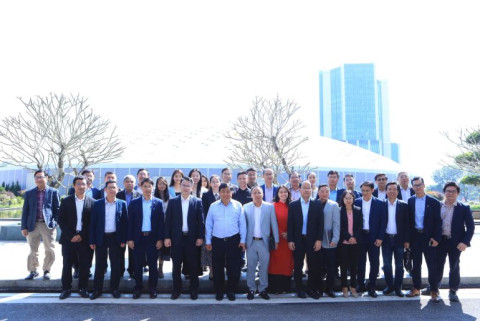Vietnam stands poised to seize opportunities in the semiconductor industry
- 29
- Business
- 11:53 06/11/2024
DNHN - In the context of a rapidly evolving global economy driven by digitalization, the semiconductor industry has emerged as a key strategic pillar.
Great opportunities, equally significant challenges
According to Trịnh Thị Tú Anh, a representative from the Lam Dong National Assembly delegation, during a discussion on socio-economic issues on the afternoon of November 4, 2024, Vietnam is at a critical crossroads in developing its semiconductor industry. While the nation possesses numerous advantages and substantial opportunities to join the global semiconductor supply chain, considerable challenges remain. Key issues, such as advancing chip production technology, training high-quality human resources, and establishing a sustainable industrial ecosystem, require urgent solutions.

Ms. Tú Anh noted that the global semiconductor industry is undergoing significant transformation, and Vietnam has the potential to become part of this shift. Major countries and corporations, including the U.S., China, South Korea, and Japan, are accelerating investment in research and development (R&D), aiming to maintain and elevate their positions within the global semiconductor supply chain. These countries benefit from advanced manufacturing technology, highly skilled workforces, and robust infrastructure, giving them a competitive edge.
Meanwhile, Vietnam holds substantial potential with its young workforce, abundant natural resources, and open-door policies attracting foreign investment. With a strategic location in Southeast Asia, Vietnam can readily connect with major markets and become a prime destination for the global semiconductor industry. However, to realize this potential, Vietnam must overcome several existing challenges.
A significant challenge for Vietnam is developing chip production technology. The semiconductor industry demands continuous technological innovation, from designing microchips to manufacturing high-performance, intricate chips. Although Vietnam has made strides in chip design, high-tech chip production—particularly for 5nm and 3nm chips—remains a major hurdle.
To make breakthroughs, Vietnam needs to invest heavily in advanced chip production technologies and encourage domestic companies to collaborate with global corporations to gain knowledge and transfer technology. Developing domestic chip production technology would reduce dependency on major chip-producing countries, create added value, and enhance Vietnam’s position in the global semiconductor supply chain.

Current state of Vietnam’s semiconductor industry
Currently, Vietnam primarily participates in semiconductor design but lacks in higher-value stages, such as production, packaging, and testing. Vietnam also struggles in high-tech chip production, particularly with advanced technologies for ultra-small, high-performance, and highly pure chips. This limitation hinders Vietnam’s competitiveness against semiconductor leaders like South Korea, Taiwan, and the United States.
A crucial factor hindering Vietnam’s semiconductor industry is workforce availability. According to Ms. Tú Anh, the demand for human resources in this sector is around 10,000 engineers per year, yet Vietnam only meets about 20% of this need. Universities and colleges lack the facilities, modern equipment, and curricula aligned with the latest advancements in semiconductor technology.
To address these issues, the government issued Decision No. 1018/QD-TTg on a strategy to develop Vietnam’s semiconductor industry by 2030, with a vision toward 2050. This strategic step aims to gradually integrate Vietnam into the global semiconductor supply chain by fostering an environment for advanced technology development and cultivating high-quality human resources to attract foreign investment.
Although the government has laid out a clear strategy, turning potential into reality requires further efforts from businesses and regulatory bodies in advancing chip production, packaging, and testing. Vietnam needs to prioritize developing advanced chip production technologies, focusing on high-purity semiconductor materials, improving chip performance, and investing in Integrated Design Automation (IDA) software to enhance productivity and precision in semiconductor design.
Human resources training as a decisive factor
Representative Đào Chí Nghĩa from the Can Tho National Assembly delegation emphasized that high-quality workforce training is crucial to the success of Vietnam’s semiconductor industry. The government aims to train at least 50,000 university-level professionals in this field by 2030, though this number still falls short of industry requirements.
Vietnamese universities and colleges currently lack sufficient capacity and facilities to train experts in semiconductors. Additionally, current training programs have not been updated to reflect the latest semiconductor technology advances. This results in uneven training quality, with graduates often not meeting the practical demands of the industry.

To remedy this, the government needs breakthrough policies for establishing specialized semiconductor industry training programs, particularly in chip design, semiconductor materials, and production. Moreover, partnerships between universities, research institutes, and businesses should be strengthened to foster a dynamic innovation ecosystem, helping generate new technological ideas and develop high-value products.
Representative Nguyễn Duy Minh from the Da Nang National Assembly delegation proposed that the government should implement preferential tax policies and incentives for semiconductor startups. These policies must create a favorable environment for innovation and support small and medium-sized enterprises in research and technology development.
In addition to human resource and technological development, a stable and sustainable energy supply is essential for the semiconductor industry. This industry requires a steady, high-quality power supply with continuous delivery that meets stringent technical standards.
In the context of climate change and the shift toward a green economy, renewable energy use has become imperative for investors. Failure to meet clean and sustainable energy demands would significantly impact Vietnam’s competitiveness in semiconductors.
The government must boost investment in renewable energy projects, especially solar and wind power, while ensuring stable development of baseline energy sources, such as thermal, gas, and nuclear power. These projects would not only provide a stable power supply for the semiconductor industry but also support Vietnam in reducing the impacts of climate change and achieving sustainable development goals.
The semiconductor industry opens a tremendous opportunity for Vietnam to emerge as a global hub for high-tech manufacturing. However, achieving this goal requires addressing major challenges in technology, human resources, and energy. The government must continue refining its semiconductor development policies and strategies while fostering an environment where businesses and educational institutions can thrive.
With robust investments in technology, human resources, and infrastructure, Vietnam could become an ideal destination within the global semiconductor supply chain, contributing to the industry’s growth not only in Southeast Asia but worldwide.
Phan Chinh
Related news
#digital technology

Viettel collaborated with Ericsson to promote the deployment of 5G networks
Viettel has partnered with Ericsson to jointly build a robust digital infrastructure, creating superior connectivity with 5G technology, bringing significant benefits to customers.

Viettel successfully deployed the first standalone 5G network in Vietnam
Viettel's deployment of a standalone 5G network promises to offer a variety of attractive services for both individual and enterprise customers.

Vietnam ranked 4th globally in mobile app downloads
This statistic highlights significant opportunities for Vietnamese app developers to learn and improve to maximize growth potential.

Vietnamese users pay special attention to security when using OTT applications
But the trend of using OTT applications among Vietnamese people also requires certain conditions, with evidence showing that not all software can succeed in the Vietnamese market.

The rapid development of TikTok and regulatory questions
Despite increased regulatory scrutiny, TikTok continues to grow in popularity. Why is it essential for this platform to increase trust and transparency in the future? Two lecturers from RMIT University explain the TikTok phenomenon.

Vietnam: One of the fastest growing app markets in the world
Vietnam is recognized as one of the fastest-growing app markets globally, with download rates increasing impressively by 40% annually over the past five years, placing it in the top 5 worldwide.
Đọc thêm Business
Connecting Leaders, Shaping the Future: Strategic Leadership Planning Meeting – CorporateConnections Hanoi A
"Your network is your most powerful flowing asset. It generates value, multiplies opportunities, and accelerates your influence across borders."
Innovative ESG enterprise: Trạm Xe Việt startup proposes solutions to build a green mobility ecosystem
As Vietnam commits to achieving Net Zero by 2050 and tightens emissions standards, the transportation sector faces unprecedented pressure to transform.
Deputy Prime Minister Nguyễn Chí Dũng: “The country’s major challenges weigh heavily on my mind — and we must resolve them together.
On the morning of November 26, 2025, Deputy Prime Minister Nguyễn Chí Dũng chaired a high-level working session at the National Innovation Center (NIC) in Hòa Lạc.
Unitsky String Technologies signs cooperation agreements with three Vietnamese partners, opening a new direction for smart mobility and sustainable development
The signing ceremony took place in Minsk, Belarus, on November 28, 2025.
Before the D‑day to abolish flat‑rate tax: Fear of technology and costs leave small traders struggling to adapt
From 1 January 2026 the flat‑rate tax regime will be abolished. Small business households will be required to declare tax based on actual revenue. MISA supports the transition with technology to help micro‑merchants adapt smoothly and transparently.
Vietnamese enterprises at a crossroads: the impact of a potential US–China deal
As the world closely monitors every shift in US-China relations, emerging signals of a strategic agreement between the two global powers are raising hopes for global economic stability.
HDBank: Impressive profit growth, leading in profitability and advancing international integration
Ho Chi Minh City Development Joint Stock Commercial Bank (HDBank, stock code HDB) announced its consolidated profit before tax for the first 9 months of 2025 reached VND 14,803 billion, marking a 17% increase year-on-year (YoY).
TNI King Coffee sued for over VND 5 Billion in unpaid debts
On October 21, 2025, the People’s Court of District 10 in Ho Chi Minh City officially accepted a civil lawsuit concerning a commercial contract dispute between TKT Vietnam Plastic Packaging Joint Stock Company and TNI King Coffee Co., Ltd.
VINASME and Jeonnam Technopark Sign MOU on technology cooperation, human resource training, and trade promotion
On October 15, 2025, in Hanoi, VINASME and Jeonnam Technopark (Korea) signed an MOU to promote trade, advance technology transfer, and develop human resources between enterprises of both nations.
Vietnamese entrepreneurs strengthen ASEAN connectivity in the digital iIntegration era
On the occasion of Vietnam Entrepreneurs’ Day (October 13), an international event themed “Integration – Innovation – Sustainable Development” was solemnly held in Ho Chi Minh City.











